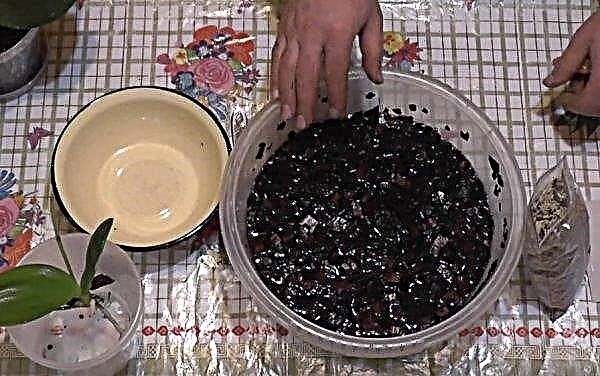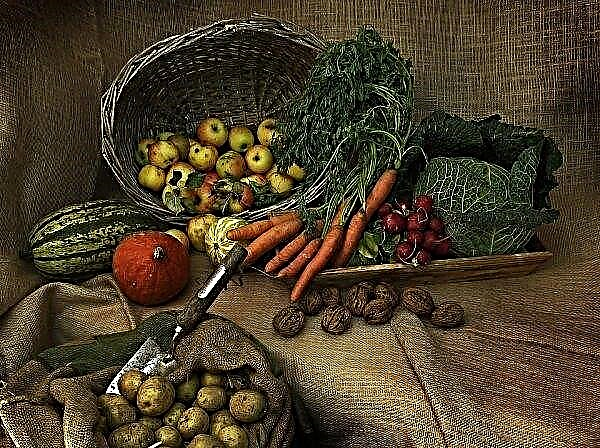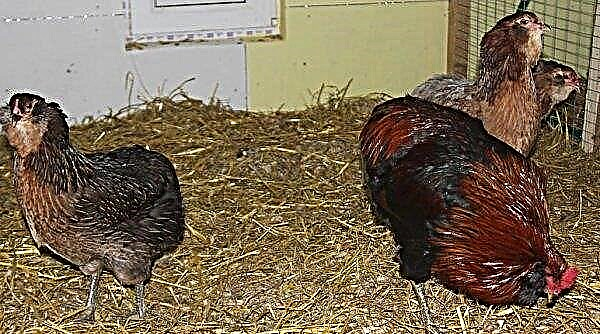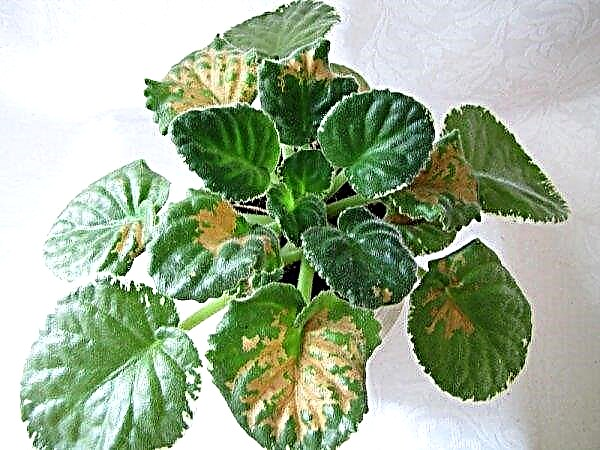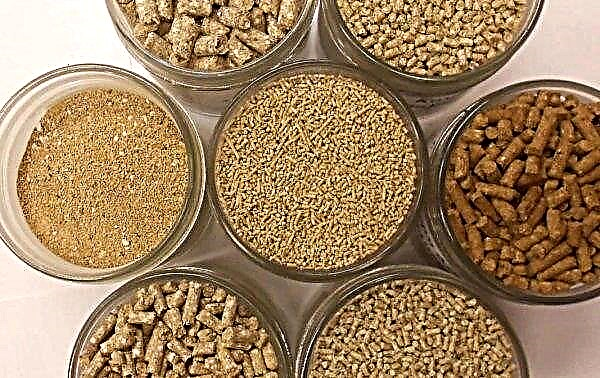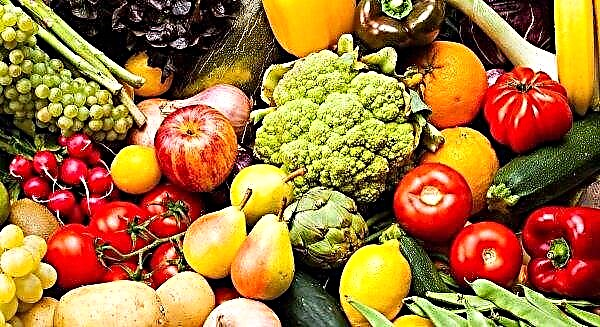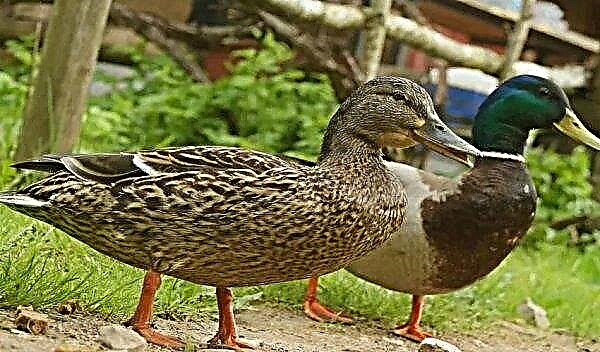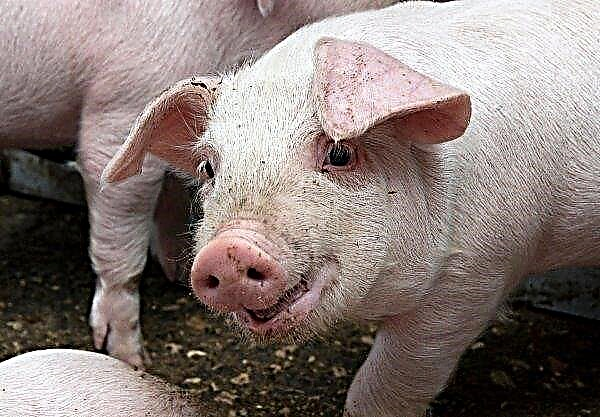Variety Brigadier F1 is a sustainable hybrid, giving the most stable crops. The seed material of such plants is not cheap, but it justifies itself with the resulting vegetable products. In this article you can familiarize yourself with the high-yielding white cabbage Brigadir F1, its cultivation, and the features of collection and storage.
History of Variety Breeding
The white cabbage variety Brigadir F1 is a 1st generation hybrid bred by the French. It was received by the breeders of the French company HM.CLAUSE S.A. In 2010, the variety was introduced in the State Register of the Russian Federation and recommended for the North Caucasus region. It can be grown on an industrial scale.
The F1 team leader became popular due to its stability and productivity, as well as the ability of unpeeled cabbage not to crack until 4-6 weeks.
Did you know? Cabbage was grown in ancient Egypt. The ancient Greeks and Romans had up to 10 varieties of this culture.
Description and characteristic
This is a mid-season cabbage variety with excellent yields. The maximum yield was achieved in the Rostov region - 710 t / ha.
Appearance of cabbage
Round heads of cabbage of Brigadir F1 variety grow with average parameters and have a very dense structure (4.8 points). Their average weight is about 3 kg, and individual specimens can grow up to 6 kg. On the leafy horizontal rosette, large, slightly mottled leaves of blue-green color are formed.
You can observe a wax coating on them. The cutaways are headed white with a small stump. The outer stump is medium long.
This variety has a high content of ascorbic acid, it can be fermented. It can also be consumed fresh and used to prepare a variety of vegetable dishes. Head of cabbage can be stored from February to March.
Ripening time
This is a mid-season hybrid, whose heads of cabbage ripen from 110–130 days from the appearance of seedlings. Productivity can fluctuate within 430–700 c / ha.
Frost resistance
The frost resistance zone of the variety is 9–10, that is, the minimum boundaries are in the range –7 ... + 4 ° С. The hybrid tolerates heat and drought, is resistant to temperature extremes.
Positive qualities and disadvantages of the variety
- The cabbage variety Foreman F1 is appreciated for the following characteristics:
- high productivity;
- good durability (shelf life - up to 5 months);
- universality of the use of heads of cabbage;
- unpretentiousness to weather factors;
- resistance to diseases and pests;
- excellent resistance to cracking.
The disadvantage of the variety is the same as that of all hybrids - it makes no sense to collect its own seeds, since the next generation will not inherit the characteristics of the mother plant. Seed material has to be purchased all the time.
Did you know? Cabbage juice can be used to treat gastritis and gastrointestinal ulcer. This effect gives her the presence of vitamin U.
Agriculture cultivating varieties
Mid-season cabbage varieties are sown on seedlings from the 10th of April. 35–45 days after the emergence of seedlings, seedlings are planted on beds.
Soaking seeds for sowing
Hybrid seeds usually undergo primary processing, and this information is indicated on the package, so they are only soaked before planting. If the seeds have not been inlaid, then it is recommended to soak them for 12 hours in a nutrient solution. For this, you can use sodium humate, "Epin." After soaking, the seed material is washed and dried on a napkin. Then, for stratification, they are moved to the shelf of the refrigerator for a day.
If the seeds have not been inlaid, then it is recommended to soak them for 12 hours in a nutrient solution. For this, you can use sodium humate, "Epin." After soaking, the seed material is washed and dried on a napkin. Then, for stratification, they are moved to the shelf of the refrigerator for a day.
If the bag does not contain any information about seed treatment, then before soaking in a nutrient solution, the seeds are soaked in potassium permanganate for 20 minutes and then washed.
Further seedling care
Sowing prepared seeds is done in seedling containers with nutrient soil, and then they are dived or immediately sown in individual dishes measuring 5 × 6 cm. Planting depth is 1-1.5 cm. These containers are covered with a film and taken to a warm place with a temperature of +18 ... + 20 ° С. Every day, the film is removed and aired crops, monitor the moisture of the soil.
When the seedlings appear, they are transferred to a cooler illuminated place with a temperature of + 7 ... + 9 ° C and kept there for 2 weeks. After this time, the temperature regime is raised to + 14 ... + 18 ° C. On 8-10 days from seedlings, pickled cabbage in separate containers, deepening the plants to cotyledon leaves.
Important! You can not abuse the watering too much to avoid the black leg. It should be watered with settled water at room temperature.
Watering is carried out as needed. The soil should be slightly damp. Cabbage seedlings are fed 2 times:
Cabbage seedlings are fed 2 times:
- A decade after the dive. To do this, irrigation is carried out with complex fertilizer (1/2 teaspoon per 1 liter) or with ammonium nitrate (2 g per 1 liter).
- 2 weeks before landing. In a 10-liter bucket spread on the table. urea and potassium sulfate.
1-2 weeks before transplanting, seedlings of cabbage begin to be taken out onto the balcony for hardening. First, it is carried out briefly in the warmest time of the day, then being outdoors is increased. By the day of planting on the beds, seedlings should already spend the night in outdoor conditions.
Preparation of the place and soil on the bed
A plot for cabbage beds is being prepared since the fall. The best soils for this vegetable are nutritious loams capable of retaining moisture with acidity in the range of 6.4–7.4 pH. It is optimal if legumes, potatoes, cucumbers, onions or garlic, tomatoes grew earlier on the plot.
Important! In places where cabbage itself or other representatives of the Cruciferous family grew, the culture is planted only after 4 years.
Sand is added to too heavy clay soil, and acidic soil is deoxidized with dolomite flour. During the autumn digging, 3-4 kg of humus (compost or rotted manure), 40 g of superphosphate and 20 g of potassium chloride are added to each m². In the spring, the soil is again dug and loosened with the simultaneous introduction of urea and ash.
Transplanting seedlings in the open ground
When planting, the seedlings should have 5-6 true leaves, and the soil should be warmed up to + 14 ° C, the average air temperature should be at least + 17 ° C. If the weather is still not so warm, then shelters should be built for planting.
The planting scheme for the Brigadir F1 cabbage cultivar is 40 × 40 cm. If the beds were not fertilized before planting, then a couple of handfuls of humus, 50 g of ash and a little nitrophoska are put in each hole, watered with settled water. Plants are buried to the top sheet and after planting, if necessary, moisten the top layer of soil.
Features cabbage care
After planting seedlings of cabbage, the Brigadier F1 should establish proper care for her.
Watering and feeding
The first week of the garden is moderately watered with not cold water. Then the cabbage is watered every 5-6 days, and in the heat - every 2-3 days. From 0.5 to 1.5 liters of water are poured under each plant. If there is rain, skip the humidification procedure.
Together with watering for the season, several top dressings are made:
- 10-14 days after transplanting seedlings. Mullein is diluted with water 1:10, ½ liter of such fertilizer is poured under each plant. If there is no organic matter, then 10 g of urea, 20 g of superphosphate and 10 g of potassium nitrate are put on a 10-liter bucket. With well-fertilized soil, this dressing can be skipped.
- A month from the landing seedlings repeat the same top dressing.
- After a couple of weeks from the second feeding 30 g of superphosphate is added to the mullein solution. You can dilute 10 g of urea and 10 g of potassium fertilizer in 10 l.

Loosening and weeding
After watering or rains, the soil is loosened, breaking the crust formed to give air access to the roots. While the plant is young and has not formed a head of cabbage, this procedure is done every week, and on heavy soils - 2 times more often. Weeds are removed as they appear.
Did you know? In Russia, cabbage has been grown since the 9th century. This vegetable became known to the Slavs from the Greeks and Romans.
Hilling bushes
Simultaneously with loosening 1 time in 20-30 days do the hilling of cabbage. This procedure is done when the root neck of the cabbage appears. This contributes to root formation and is the prevention of weeds.
Pest and Disease Control
The variety is notable for its high resistance to diseases and pests due to the presence of a wax coating.
It is not as susceptible to Fusarium as other varieties.
But still, the plant can be affected by the following diseases:
- Kila. This fungal disease affects the roots. The leaves turn yellow and fade, growths on the stalk appear, a slowdown in the development of plant culture is observed. Affected specimens should be removed from the garden bed and disinfected with Bordeaux mixture. For prevention, fertilizers containing calcium, colloidal sulfur, ash are applied to the soil.
- White rust. Symptoms of the disease are a powdery whitish coating on the leaves. For the fight, the chemical product "Ridomil Gold" is used.
- Powdery mildew. It is revealed by a whitish coating on the sheets, which after a while acquires a brownish color. The leaves undergo a deformation process and dry. To eliminate the problem, Topaz, Fundazim, and Fundazol drugs are used.
- Peronosporosis. Such a fungal disease is detected in the appearance of gray-yellow spots on the leaves and white plaque. To combat the treatment with drugs "Ridomil Gold", "Fitoftorin."
- Rhizoctonia. When this disease appears, the root neck becomes thinner and darker. Processing should be carried out with the chemical preparation “Fitolavin-300”.
- Late blight. Leaves acquire a brown color. The plant should be removed from the site.
- Blackleg. The root neck becomes thin and darkens. At the first signs, the plant should be poured with a solution of potassium permanganate (0.5 g of potassium permanganate per 1 liter of water).
- Fusarium wilt. Leaflets begin to turn yellow and die. Affected specimens are removed, and also treated with fungicidal agents “Topsin-M”, “Tecto”, “Benomil”.








Cabbage can be invaded by pests such as cabbage fly, babanuha, whitefly, whitewash, and fire-light. Chemicals are used for control spraying - these are “Thiophos” or “Chlorophos”, glue traps.
As a prevention of pests and diseases, agricultural cultivation techniques, crop rotation, weed control, seed disinfection and preventive treatment of cabbage with Bordeaux liquid, Hom, Energen, and Fitolavin preparations should be observed.
Features of harvesting and storage of crops
The specified variety is well suited for fresh or pickled form. Cabbage can be stored for 4–5 months, until March.
21 days before harvesting, watering is stopped. Heads of cabbage should be torn off before the onset of frost, since low temperatures will negatively affect the quality of the product. The heads of cabbage are cut with a well-sharpened knife, leaving leaves and a stalk about 3 cm. The collected fruits are sorted out, sorting specimens with cracks, mechanical damage and rotten. Cabbage is placed under a canopy for 1 day so that it dries. After removing the stump and moving to a cool dark storage room. The optimum temperature is 0 ... + 2 ° C, humidity - 95–98%.
The collected fruits are sorted out, sorting specimens with cracks, mechanical damage and rotten. Cabbage is placed under a canopy for 1 day so that it dries. After removing the stump and moving to a cool dark storage room. The optimum temperature is 0 ... + 2 ° C, humidity - 95–98%.
Important! The basement must be prepared for storage: the room must be well dried and treated with an antiseptic, such as quicklime. If there are rodents, then you must get rid of them.
Cabbage is placed with stitches up on shelves or the floor, which are previously covered with dry straw.
Cabbage varieties Brigadir F1 is a high-yielding mid-season hybrid, resistant to disease and drought. It is recommended to grow in seedlings. Heads of this variety can be laid for storage, eat fresh, used for harvesting, including pickling.



